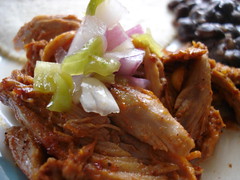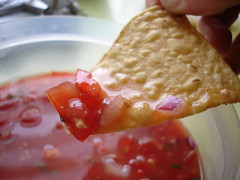Little Old Lady From Cozumel
 fig. a: tortilla press: Hecho en Mexico
fig. a: tortilla press: Hecho en Mexico
So it was just before Christmas and we were in the process of finalizing our holiday food shopping. Christmas Eve was accounted for, Christmas was accounted for--Boxing Day was the only remaining question mark before New Year's. Except that it wasn't that much of a question mark. We'd enjoyed our Boxing Day meal--a home version of the classic Puerco Asado a la Cubana--so religiously the year before that we knew we wanted to stick with some kind of Latin American-style, slow-roasted pork dish. But the question was, do we repeat last year's recipe, or do we try something brand-new? As much as we love testing out new recipes, there's also something to be said for the tried and true, for tradition, and we're definitely not the kind of people who feel the need to innovate at every turn. So we were leaning towards an encore performance of the Puerco Asado a la Cubana when, suddenly, things took an unexpected turn.
You see, we'd just picked up a lovely pork shoulder from Porc Meilleur at Jean-Talon Market, and I'd already made sure that we had plenty of sour orange juice (i.e. Seville orange juice) at home in the freezer. We didn't need all that much more in the way of ingredients in order to make that succulent Cuban-style pork--just some Mexican oregano and some banana leaves and we were good to go. But when we stopped in at Olives & Épices to pick up the Mexican oregano, our good friends Ethné and Philippe were there, and the next thing we knew we got wrapped up tighter than a pork shoulder in a banana-leaf envelope in a full-on roast pork referendum. It's not that Ethné and Philippe didn't like the sound of our menu--they did--it's just that their book having just come out recently, they had Latin American roast pork ideas of their own.
So they started telling us about Yucatecan Cochonita Pibil and it's safe to say we liked what we heard. Like Puerco Asado a la Cubana, Cochonita Pibil is slow-cooked in a pit (or pib as it's known in the Mayan tongue), and it, too, is traditionally made with a suckling pig, as the Spanish term cochonita implies. As in the Cuban version, the pit barbecue appears primitive--a rectangular pit, 2 feet deep, is lined with stones that are then heated with a wood fire, the meat is then wrapped in banana leaves, placed in a metal container, covered, and slow-cooked for hours--but it requires a great deal of expertise to get optimum results and each community has its ackowledged master/s. Digging a pit in Montreal in December poses a bit of a problem to those aspiring to make a truly authentic Cochonita Pibil for the holidays, but, as with Puerco Asado a la Cubana, it's possible to make a convincing and utterly delicious home version. The primary difference between the two dishes has to do with marinades: while the Puerco Asado a la Cubana's consists primarily of simple blend of garlic, sour orange juice, and herbs, the Cochonita Pibil's is even more exotic, with the gorgeous color and haunting flavor of achiote seeds (bixa orellana, the outer layer of the hard seed of a tropical tree native to the Yucatan that's also known as anatto or annatto in English, rocou in French) playing a prominent role.
The Cochonita Pibil seemed like a perfect compromise--some degree of familiarity, some degree of innovation--and we were already sold on the idea, when Philippe sealed the deal: he took us to his freezer and told us about the Little Old Lady From Cozumel. Now, I'm not sure what kind of car, if any, the Little Old Lady From Cozumel drives, and I have no idea if she's a hot-rodder, but I do know that she makes her Recado Rojo--achiote paste--according to a time-honored recipe, and that the De Viennes have a contact in neighboring Cancun who ships her Recado Rojo to Montreal fresh on a regular basis. Of course, you could make your own Recado Rojo (and you'll find directions to do so below), but chances are you've never had a traditional Yucatecan Cochonita Pibil before--we certainly hadn't. That being the case, why wouldn't you want the Little Old Lady From Cozumel on your team, helping things along?
 fig. b: Cochonita Pibil with fresh tortillas and refried black beans
fig. b: Cochonita Pibil with fresh tortillas and refried black beans
Cochinita Pibil, a.k.a. Yucatecan "Pit-Barbecued" Pig
4-lb pork shoulder
banana leaves, thawed and wiped clean
4 tbsp recado colorado or recado rojo (recipe follows)
6 cloves garlic
1/2 cup Seville orange juice or mild white vinegar
2 tsp salt
Pierce the pork shoulder all over and rub in 2 teaspoons of the salt and 2 tablespoons of the juice.
Crush the garlic cloves and mix them with the recado colorado and the remaing Seville orange juice. Smear this mixture all over the pork shoulder making sure to cover it thoroughly.
Wrap the pork in the banana leaves and allow to season in the refrigerator for a minimum of 6 hours and preferably overnight.
Preheat the oven to 300º.
Place a rack at the bottom of a Dutch oven and set the wrapped meat on it. Add the water and cover the dish with a tightly fitting lid. Cook for 2 1/2 hours. Remove the Dutch oven from the oven. Turn the meat and baste it well with the juices at the bottom of the dish. Place the Dutch oven back in the oven and cook for another 2 1/2 hours, or until the meat quite literally falls off the bone and shreds with ease.
After you return the pork to the oven to finishing cooking, prepare the sauce.
sauce:
1/2 cup finely chopped red onion
3 habañero chiles, minced
1/2 tsp salt
2/3 cup seville orange juice or mild white vinegar
Mix all the ingredients together. Set aside to mellow for 2 hours.
To serve the pork, shred the meat roughly. Pour the fat and juices from the pan over it. Serve hot with tortillas and condiments and the sauce in a separate dish so that each person can make his or her own tacos.
[recipe based on Diana Kennedy's Cochonita Pibil from The Essential Cuisines of Mexico and on Ethné and Philippe de Vienne's Cochonita Pibil from La Cuisine et le Goût des Épices]
If you don't happen to live in Montreal, and therefore don't have access to the Little Old Lady From Cozumel's magic via Olive et Épice's freezer, or if you absolutely insist on making your own Yucatecan recado, here are two different versions:
Recado Colorado
1/4 cup achiote seeds
1 tsp allspice
1/2 tsp clove
1/2 tsp cumin
2 tsp dried mexican oregano, Yucatecan if possible
1 tsp salt
1/8 tsp powdered chile seco Yucateco or hot paprika
Seville orange juice or mild white vinegar
In an electric spice grinder, grind the achiote seeds, cumin, oregano, peppercorns, and allspice together in a fine powder.
Add just enough Seville orange juice or vinegar to make a firm paste.
[recipe from Ethné and Philippe de Vienne's La Cuisine et le Goût des Épices]
Simple Recado Rojo
4 rounded tbsp achiote seed
1 tsp crushed dried Mexican oregano, preferably Yucatecan
1 tsp cumin seeds
1/2 tsp mild black peppercorns
12 whole allspice
3 tbsp water, approximately
Mix the spices and grind one third of the quantity at a time--or as much as your spice grinder can safely accomodate at a time. Make sure to grind them as finely as possible. Sift the ground spices through a fine strainer and grind the residue once again. Stir the water in gradually and mix well to a stiff paste.
If you are not going to use the paste immediately, form it into a round thick cake and divide into four pieces. Wrap well and store in the freezer compartment of the refrigerator. This method makes it easier to use later.
To dilute for use, crush this amount with about 20 small garlic cloves and sea salt to taste, and dilute to a thin cream with bitter orange juice or its substitute, a mild vinegar.
[recipe from Diana Kennedy's The Essential Cuisines of Mexico]
Our default salsa is a blackened tomato salsa that I devised a number of years ago after a trip to California, but this meal was begging for a Yucatecan version, so that's exactly what we made. Two words of advice: 1) don't fear the habañeros and 2) use the best tomatoes you can get your hands on. If you don't yet have a salsa that you call your own, this Salsa Xi Ni Pek is pretty much a perfect fresh salsa and it's dead-simple to make. Win-win.
 fig. c: Salsa Xi Ni Pek
fig. c: Salsa Xi Ni PekSalsa Xi Ni Pek, a.k.a. Yucatecan fresh salsa
1/2 cup tomatoes, finely chopped
1/2 cup red onion, finely chopped
2 habañeros, finely chopped
1/4 cup Seville orange juice or mild white vinegar
1/2 tsp salt
1 tbsp finely chopped cilantro
Mix all the ingredients and let stand 30 minutes to allow the flavors to mingle.
[recipe from Ethné and Philippe de Vienne's La Cuisine et le Goût des Épices]
We hadn't made corn tortillas in quite some time--Tortilleria Maya, nearby, has made us lazy--but Philippe insisted that if we were going to the lengths of making Cochonita Pibil that we absolutely had to make our own tortillas (hence the photo up-top). Who were we to argue?
Corn Tortillas
1 1/4 pounds tortilla masa
water if needed
2 1-litre plastic bags for pressing tortillas
If the tortilla masa has been freshly made [we wish!], it will probably be the right consistency for working immediately--a soft, smooth dough. If the masa has been sitting around and drying out a little, then add a very little water and knead until it's smooth and pliable, and not the slightest bit crumbly.
Divide the dough into 15 equal parts--each should weigh just over 1 ounce (30 g)--and roll them into smooth balls about 1 1/2 inches in diameter. Place all but one of the balls under plastic wrap so they do not dry out.
Heat an ungreased comal or griddle or cast-iron pan over medium heat. Open up the tortilla press and place a small plastic bag on the bottom plate. Place a ball of the dough on the bottom plastic bag, a little off center toward the hinge rather than the pressing lever, and press it out with your fingers to flatten it a little. Cover with the second platic bag and press down firmly but not too violently. Open the press, remove the top bag, lift the bottom bag up in one hand, place the dough onto the fingers of your other hand, and very carefully peel the bag off the flattened dough. Do not try to peel the dough off the bag.
Keeping your hand as horizontal as possible, lay the tortilla flat onto the comal/griddle/cast-iron pan. There should be a slight sizzle as the dough touches the surface of the comal. Leave for about 15 seconds; the underside will have opaque patches and be slightly speckled with brown. Flip the tortilla over onto the second side and cook for another 30 seconds; the underside should now be opaque and speckled. Flip back onto the first side again and cook for 15 seconds more.
If you have done everything correctly and the comal is the right heat, the tortilla should puff up, showing that the extra moisture has dried out of the dough.
As the tortillas are made, they should be placed one on top of the other in a basket lined with a cloth to preserve the heat and keep them moist and supple.
Tortillas can be made ahead and reheated and they can also be frozen.
[recipe from Diana Kennedy's The Essential Cuisines of Mexico]
Was the Cochonita Pibil good? Do you even have to ask? It was phenomenal. I mean, just look at that photo above. Now, I'm not sure that that picture is worth a thousand words, but it is worth a least a few and all of them are making me hungry.
Oh, and if you're worried about taking the plunge with achiote paste, worried that you're not ready to commit to making Yucatecan Barbecued Pork more than once over the next several months, or if you're just not that into pork in the first place, fret not. Achiote paste makes for an outstanding and substantially less involved Yucatecan "Barbecued" Chicken too, as we found out just a few days later.
Pollo Pibil, a.k.a. Yucatecan "Barbecued" Chicken
1 chicken, cut into pieces
4 tbsp achiote paste
4 tbsp water
salt to taste
1 large banana leaf, torn into two pieces and cleaned with a wet paper towel
2 tbsp lard or vegetable oil
1 white onion, sliced thinly
2 tomatoes, sliced
1 tsp achiote paste
Prick the chicken pieces all over with a fork. Dilute the achiote paste with water and set 1 tsp aside. Thoroughly rub the remainder, along with the salt, into the chicken.
Wrap the banana leaf around the chicken to make an envelope. Set it aside to season, refrigerated, for several hours or overnight.
Preheat the oven to 375º F.
Heat the oil or lard in a skillet and fry the onion until translucent. Add the tomatoes and the extra teaspoon achiote paste and fry the slices gently on both sides.
Unwrap the chicken. Put half the onion and tomato under the chicken and the other half on top. Wrap it up again to make a tight envelope.
Place the envelope into a Dutch oven and cover it tightly. Cook for 20 minutes. Turn it over, baste with the juices, and cook for another 20 minutes, or until just tender and cooked through. Do not overcook.
Turn the oven up to 450º F, remove the cover, open up the leaf, and let the chicken brown on top.
Serve, still wrapped in the banana leaf, with fresh tortillas and condiments of your choosing.
[recipe adapted from Diana Kennedy's The Essential Cuisines of Mexico
This chicken was another huge coup. One particularly enthusiastic guest declared that it was the best Mexican-style chicken he'd ever had, anywhere: California, Mexico, whatever.
How's that for a flurry of recipes?
aj









5 comments:
Wow that is a flurry of recipes! It is a good thing too 'cause I have most of the ingredients in the house and as soon as this cold snap breaks I'm off to Olives & Epices for some of that great Mexican oregano and I'm picking up that lil ol' lady from Cozumel! We are going to cook together. Now if my fingers will only thaw out for a minute I'll have a cup of coffee to warm up and dream of my pork feast, thank you so much for sharing. Damn, it's cold today.
well, its been a while, but i read this post and just said 'oh...yeah' Bourdain-style. BBQ. Mex. Chicken. Tortilla. simply impossible not to appreciate. oh yeah.
Yum, the perfect menu for the freezing weather we're having these days!
I bought the De Viennes' book this past weekend — what a treat! Do you have any idea if there are plans to publish an English version?
I needed some cooking inspiration for this weekend, and I think that this is just the thing! Tell me, as a newbie to Montreal, where can I get banana leaves? I'll head up to JTM for that achiote paste!
Conveniently, Olives & Épices' sister store, La Dépense (also at J-T Market), carries frozen banana leaves (don't worry, they thaw out easily and quickly), but more generally you can find them in the freezers of many of the city's Asian grocery stores, especially its Thai grocery stores.
Post a Comment